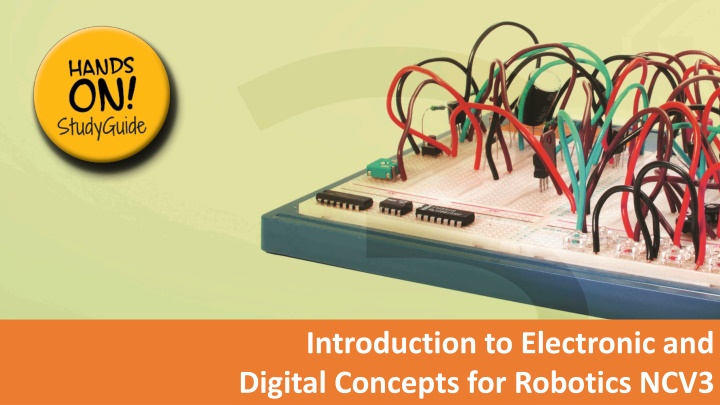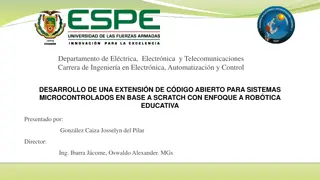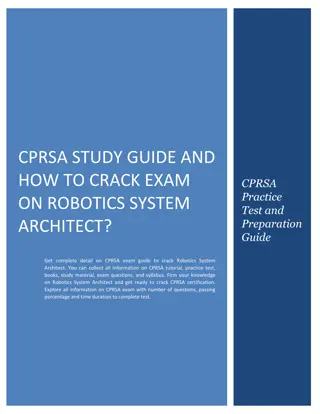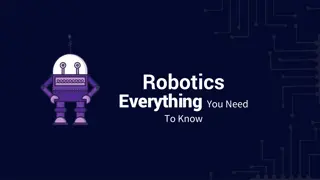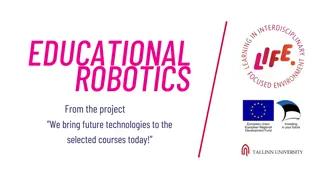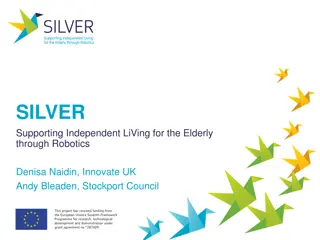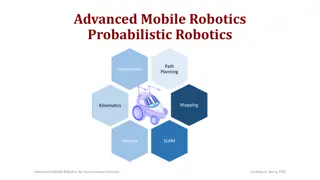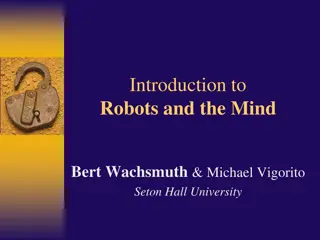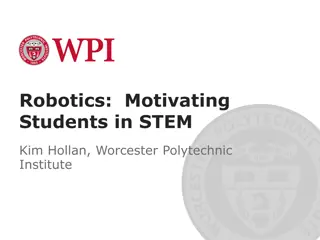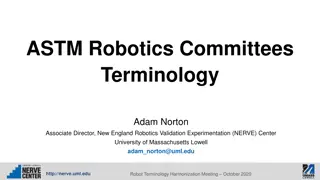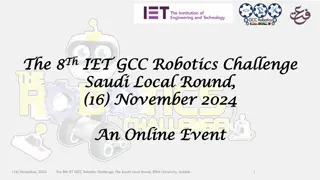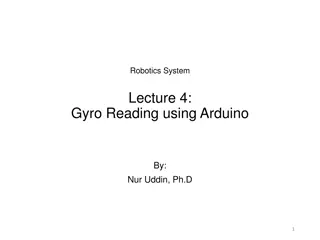Introduction to Electronic and Digital Concepts for Robotics
Electricity and magnetism are closely related concepts crucial for understanding robotics. Module 1 discusses magnetism, electromagnetic circuits, and electromagnetism, exploring topics such as magnetic circuits, poles, electromagnets, and induction. Module 2 delves into electrical supply systems, transformers, DC machines, and series-parallel networked circuits, covering aspects like electricity generation, transmission, distribution, and the use of transformers in electronics with calculations using series-parallel network circuits.
Download Presentation

Please find below an Image/Link to download the presentation.
The content on the website is provided AS IS for your information and personal use only. It may not be sold, licensed, or shared on other websites without obtaining consent from the author.If you encounter any issues during the download, it is possible that the publisher has removed the file from their server.
You are allowed to download the files provided on this website for personal or commercial use, subject to the condition that they are used lawfully. All files are the property of their respective owners.
The content on the website is provided AS IS for your information and personal use only. It may not be sold, licensed, or shared on other websites without obtaining consent from the author.
E N D
Presentation Transcript
Introduction to Electronic and Digital Concepts for Robotics NCV3
Module 1: Magnetism, electromagnetic circuits and related concepts INTRODUCTION Electricity and magnetism are very closely related. They have a mutually interdependent relationship. Magnetism is a fascinating concept and one of the most important ones to understand, as it is the building block for several electrical components, such as transformers and motors. Magnets and magnetism are very much part of our lives round magnets are found in speakers; magnetic resonance imaging (MRI); and magnetic strips have long been used to store data. www.futuremanagers.com
Module 1: Magnetism, electromagnetic circuits and related concepts (continued) MAGNETIC CIRCUITS Magnets can be used within a magnetic circuit. All magnets have two poles: a north pole and a south pole. The poles behave like magnetic charges. www.futuremanagers.com
Module 1: Magnetism, electromagnetic circuits and related concepts (continued) ELECTROMAGNETISM AND ELECTROMAGNETIC INDUCTION It is important that you understand magnetism, the right- and left-hand rules, solenoids and electromagnets. There are three types of magnets: Natural magnets; Permanent magnets; and Manufactured and electromagnets (temporary magnets). www.futuremanagers.com
Module 2: Electrical supply systems, transformers, DC machines, series-parallel networked circuits INTRODUCTION When dealing with the distribution of electrical energy, we split the system into three parts. The first part deals with electricity generation, the second with how the electrical energy is transmitted via high-voltage cables (called transmission lines), and the third part focuses on how the electrical energy is distributed to the electricity consumers. The consumers require electricity to run their machines and equipment, which could either be connected in series, parallel or a combination of the two. www.futuremanagers.com
Module 2: Electrical supply systems, transformers, DC machines, series-parallel networked circuits (continued) TRANSFORMERS Transformers are basic components used in electronics. They work on the principle of electromagnetism and a process called mutual induction. www.futuremanagers.com
Module 2: Electrical supply systems, transformers, DC machines, series-parallel networked circuits (continued) CALCULATIONS USING SERIES-PARALLEL NETWORK CIRCUITS When working with electronic circuits, you must understand the purpose of components, what effect they have in a circuit, and how you could use that knowledge to your advantage in circuit design. www.futuremanagers.com
Module 2: Electrical supply systems, transformers, DC machines, series-parallel networked circuits (continued) SOLAR CELLS Solar cells, or photovoltaic cells, convert light energy into electricity. www.futuremanagers.com
Module 2: Electrical supply systems, transformers, DC machines, series-parallel networked circuits (continued) DC MACHINES DC machines are powered through direct current, such as batteries, DC power supplies or an AC-to-DC power converter. DC machines can be connected as either a motor or as a generator. The functions of motors and generators differ in terms of energy conversion. An electric motor converts electrical energy into mechanical energy, while a generator converts mechanical energy into electrical energy. www.futuremanagers.com
Module 3: Electronic components and semiconductors INTRODUCTION Electronic components and semiconductors are vital to the functioning of many devices commonly used today and to the development of robots and robotics. www.futuremanagers.com
Module 3: Electronic components and semiconductors (continued) CALCULATING THE RESISTANCE OF A MATERIAL Anything that conducts electricity has a certain resistance. This resistivity, or specific resistance, refers to how much a certain conductor opposes the flow of current through the material. Some materials are better conductors than others. www.futuremanagers.com
Module 3: Electronic components and semiconductors (continued) CHARACTERISTICS AND OPERATION OF SEMICONDUCTOR DIODES A diode has two terminals: the anode (positive) and the cathode (negative). Diodes allow current to flow in only one direction almost like a one-way street. Most diodes are made of a semiconductor material, usually silicon. Diodes can consist of two electrodes placed inside a sealed vacuum tube. Diodes are passive electronic devices, like resistors and capacitors. www.futuremanagers.com
Module 3: Electronic components and semiconductors (continued) BIPOLAR JUNCTION TRANSISTORS Bipolar transistors are types of transistors that use both electrons and electron holes as charge carriers. www.futuremanagers.com
Module 3: Electronic components and semiconductors (continued) THE CHARACTERISTICS AND APPLICATION OF OPERATIONAL AMPLIFIERS (OP-AMPS) Operational amplifiers (op-amps) are widely used in electronic circuits. An op-amp is a three- terminal device that can amplify weak electrical signals. www.futuremanagers.com
Module 3: Electronic components and semiconductors (continued) CAPACITORS IN SERIES, PARALLEL AND SERIES-PARALLEL Capacitors store electrical energy for short periods. They are passive components; this means they rely on current flowing through the circuit. The capacitance of a capacitor is determined by the size of the plates as well as the distance between them. If capacitors are connected in series, the gap between the plates widens. If capacitors are connected in parallel, the plate area increases and the gap between the plates stays the same. www.futuremanagers.com
Module 3: Electronic components and semiconductors (continued) INDUCTORS IN SERIES, PARALLEL AND SERIES-PARALLEL Inductance is the tendency of an electrical conductor to oppose a change in the electric current flowing through it. Inductors that are connected in series allow one path for current to flow, and the resistance of the wires used is like that of resistors connected in series. Inductors connected in parallel allow multiple paths for current to flow, and the resistance of the wires used is like that of resistors connected in parallel. www.futuremanagers.com
Module 3: Electronic components and semiconductors (continued) HOW CONTROLLERS SENSE AND REACT TO PHYSICAL CONDITIONS Electronic controllers operate using electrical signals and digital algorithms. They perform receptive, comparative and corrective functions using technology to ensure that all components are optimally controlled. This can result in efficient processes and reduced energy consumption. www.futuremanagers.com
Module 4: Electrical components, symbols, circuit drawings, prototyping and design INTRODUCTION To work in the field of electricity and electronics, you must be familiar with the different electrical components, their symbols and their applications. From time to time, you might also be required to build circuits on a breadboard, Veroboard or printed circuit boards (PCB). www.futuremanagers.com
Module 4: Electrical components, symbols, circuit drawings, prototyping and design (continued) SYMBOLS OF ELECTRONIC COMPONENTS For easy identification, each component has its own unique symbol. Knowing these symbols will help you understand an electrical circuit. www.futuremanagers.com
Module 4: Electrical components, symbols, circuit drawings, prototyping and design (continued) BREADBOARDS AND VEROBOARDS A breadboard is a thin, plastic board with tiny holes for building an experimental model of an electric circuit. A veroboard is a board used to build electronic circuits; some of the electrical connections are formed by strips of copper on the underside of the board. www.futuremanagers.com
Module 4: Electrical components, symbols, circuit drawings, prototyping and design (continued) THE COMPOSITION AND DESIGN OF ELECTRIC CIRCUITS A circuit can consist of any number of different components joined in various ways to form a conductive path through the circuit. www.futuremanagers.com
Module 5: Electronic tools and equipment INTRODUCTION Measuring instruments are used to test, calculate and measure the values of electrical quantities such as current, voltage, resistance and power. These devices must be handled with care if they are to have a long service life. www.futuremanagers.com
Module 5: Electronic tools and equipment (continued) USING AND LOOKING AFTER ELECTRONIC MEASURING INSTRUMENTS Taking good care of the instruments you use is of the utmost importance for the following reasons: It increases accuracy of readings; It ensures longer service life; and It is more economical in the long run. www.futuremanagers.com
Module 6: Digital systems, PLCs and principles INTRODUCTION Basic digital and logic concepts are the building blocks of all digital equipment including computers, banking, communication systems and modern vehicles. Digital devices can be programmed to perform various functions and are used in various applications in industries such as the steel industry, automobile industry, chemical industry and the energy sector. www.futuremanagers.com
Module 6: Digital systems, PLCs and principles (continued) THE USE OF LOGIC GATES A logic gate is a device that performs a Boolean logic operation on one or more binary inputs and then outputs a single binary output. The output of a gate is always determined by the type of gate as well as the inputs to the gate. www.futuremanagers.com
Module 6: Digital systems, PLCs and principles (continued) LOGIC DESIGN Digital logic is the underlying logic system that drives electronic circuit-board design. It is a system that uses simple numerical values to produce input and output operations. www.futuremanagers.com
